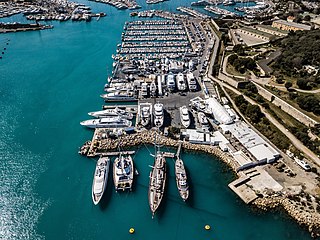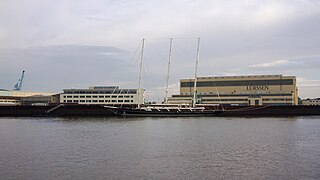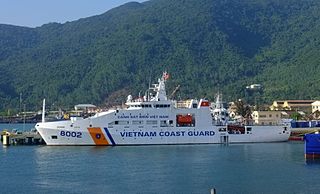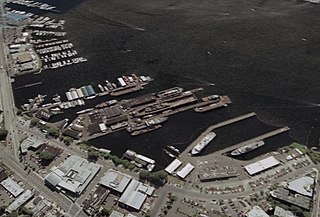
Blohm+Voss (B+V), also written historically as Blohm & Voss, Blohm und Voß etc., is a German shipbuilding and engineering company. Founded in Hamburg in 1877 to specialise in steel-hulled ships, its most famous product was the World War II battleship Bismarck. In the 1930s, its owners established the Hamburger Flugzeugbau aircraft manufacturer which, shortly before the outbreak of World War II, adopted the name of its parent company. Following a difficult period after the war, B+V was revived, changing ownership among several owners, as Thyssen Group and Star Capital. In 2016, it became a subsidiary of Lürssen and continues to supply both the military and civilian markets. It serves two areas – new construction of warships as NVL B.V. & Co. KG, and new construction and refitting of megayachts. The company has been in operation, building ships and other large machinery, almost continuously for 147 years.

Lowestoft is a coastal town and civil parish in the East Suffolk district of Suffolk, England. As the most easterly UK settlement, it is 110 miles (177 km) north-east of London, 38 miles (61 km) north-east of Ipswich and 22 miles (35 km) south-east of Norwich, and the main town in its district. The estimated population in the built-up area exceeds 70,000. Its development grew with the fishing industry and as a seaside resort with wide sandy beaches. As fishing declined, oil and gas exploitation in the North Sea in the 1960s took over. While these too have declined, Lowestoft is becoming a regional centre of the renewable energy industry.

A shipyard, also called a dockyard or boatyard, is a place where ships are built and repaired. These can be yachts, military vessels, cruise liners or other cargo or passenger ships. Compared to shipyards, which are sometimes more involved with original construction, dockyards are sometimes more linked with maintenance and basing activities. The terms are routinely used interchangeably, in part because the evolution of dockyards and shipyards has often caused them to change or merge roles.
British Shipbuilders (BS) was a public corporation that owned and managed the shipbuilding industry in Great Britain from 1977 through the 1980s. Its head office was at Benton House in Newcastle upon Tyne, England.

Lürssen is a German shipyard with headquarters in Bremen-Vegesack and shipbuilding facilities in Lemwerder, Berne and Bremen-Fähr-Lobbendorf.

The Damen Group is a Dutch defence, shipbuilding, and engineering conglomerate company based in Gorinchem, Netherlands.

HMCS Stadacona was a commissioned patrol boat of the Royal Canadian Navy (RCN) that served in the First World War and postwar until 1920. Prior to entering service with the RCN, the vessel was the private yacht Columbia. Following the war, Stadacona performed hydrographic surveys. The vessel was sold for commercial use in 1920 and was burned for salvage in 1948. Stadacona is a historic name associated with Canada, the voyages Jacques Cartier, the colony of Samuel de Champlain, and Quebec City.
Appledore Shipbuilders is a shipbuilder in Appledore, North Devon, England.

Lake Union Dry Dock Company is a full-service shipyard that specializes in vessel repair and conversions located in Seattle, Washington. Drydocking vessels up to 6,000 tonnes, , Lake Union Dry Dock Company repairs factory trawlers, fishing vessels, Coast Guard Cutters and buoy tenders, tugboats, research vessels, ferries, mega-yachts, barges, and houseboats.

Naval trawlers are vessels built along the lines of a fishing trawler but fitted out for naval purposes; they were widely used during the First and Second World Wars. Some—known in the Royal Navy as "Admiralty trawlers"— were purpose-built to naval specifications, others adapted from civilian use. Fishing trawlers were particularly suited for many naval requirements because they were robust vessels designed to work heavy trawls in all types of weather, and had large clear working decks. A minesweeper could be created by replacing the trawl with a mine sweep. Adding depth charge racks on the deck, ASDIC sonar below, and a 3-inch (76 mm) or 4-inch (102 mm) gun in the bow equipped the trawler for anti-submarine duties.

The Port of Lowestoft is a harbour and commercial port in Lowestoft in the English county of Suffolk owned by Associated British Ports. It is the most easterly harbour in the United Kingdom and has direct sea access to the North Sea. The harbour is made up of two sections divided by a bascule bridge. The inner harbour is formed by Lake Lothing whilst the outer harbour is constructed from breakwaters. Lowestoft handles around 30,000 tonnes of cargo per year.

General Engineering & Dry Dock Company was a shipbuilding and ship repair company in Alameda, California that was active from the 1920s through the 1940s. The company built ships for the Southern Pacific Railroad and the United States Coast Guard in the late 1920s and early 1930s and took part in the World War II shipbuilding boom, making diesel-propelled steel hulled auxiliaries for the United States Navy, primarily oceangoing minesweepers.

George Lawley & Son was a shipbuilding firm operating in Massachusetts from 1866 to 1945. It began in Scituate, then moved to Boston. After founder George Lawley (1823–1915) retired in 1890, his son, grandson and great-grandson upheld the business, which continued until 1945. Of the hundreds of ships built by the Lawleys, highlights include the yachts Puritan and Mayflower, respective winners of the 1885 and 1886 America's Cup.
Henry B. Nevins Incorporated was wooden-hull yacht builder in City Island, New York founded in 1907 by Henry B. Nevins. Nevins was a master yacht builder and author on vessel construction who apprenticed at the island's Charles L. Seabury & Company. Later he purchased the nearby Byles Yard to increase his company's acreage. Henry B. Nevins Inc. built custom sail and motor yachts and racing craft for affluent clients, but also small tugs and barges for commercial customers. Run by a perfectionist, Nevins' company seasoned its own lumber, designed and machined its own fittings, made its own glue, and balanced spars by weighing shavings. As a result, Nevins built more cup-winning yachts than anyone else in the industry.

Constructions Mécaniques de Normandie (CMN) is a French shipyard located at Cherbourg. It employs approximately four hundred employees covering the various specialities required for the construction of luxury yachts and warships.
The Greenport Basin and Construction Company, known by various names throughout its history, but most recently named the Greenport Yacht & Shipbuilding Company, is a shipbuilder in Greenport, Suffolk County, New York. It was established in the 19th century by brothers Pliny C. Brigham and Theodore W. Brigham. One local history relates:
Greenport prospered due to the menhaden industry; 64 boats were in service and seven under construction in 1879. By this time, shipbuilding boomed in Greenport. The Greenport Basin and Construction Company, famous yacht builders, became a large repair and docking facility for menhaden vessels. Menhaden vessels or "bunker boats" were said to have lined the shoreline along Main and Front Streets.
Peterson Builders Incorporated (PBI) was an American ship building company that constructed small to medium, naval and commercial ships and boats. The company mainly operated from a shipyard in Sturgeon Bay, Wisconsin. Spare parts and logistics were managed from Virginia Beach, Virginia and a ship repair operation in Ingleside, Texas made up part of PBI.

The maritime industries of Taiwan are a large part of Taiwan's economy. Industries of particular importance are shipbuilding, boat building, maritime transport, aquaculture, mariculture, commercial fishing, seafood processing, offshore wind power and various forms of tourism. Deep sea mining, especially of dormant hydrothermal vents, is also being considered for the future. In 2018 Taiwan was the fourth largest yacht building nation. Taiwan is home to a number of maritime museums and maritime colleges.
Richards (Shipbuilders) Ltd was a shipyard in Lowestoft, Suffolk and Great Yarmouth, Norfolk

Astoria Marine Construction (AMCCO) was founded as Astoria Shipbuilding by Joe Dyer is 1929 in Jeffers Gardens of Astoria, Oregon. Joe Dyer's father was a pioneer of early Astoria and operated a family sawmill. Joe Dyer started by building wooden fishing boats at his shipyard. Then added wooden pleasure craft to his product line. Joe Dyer designed and built Columbia River One Design (CROD) boats and boats for the United States Navy. The shipyard was on the east bank of the Lewis and Clark River and the Jeffers Slough. Due to its historical importance the site is on the National Register of Historic Places in Clatsop County, Oregon. Astoria Marine Construction shipyard closed in 2013.















